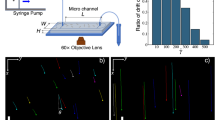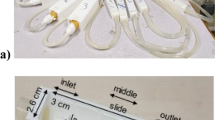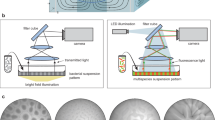Abstract
Bacteria often live in dynamic fluid environments1,2,3 and flow can affect fundamental microbial processes such as nutrient uptake1,4 and infection5. However, little is known about the consequences of the forces and torques associated with fluid flow on bacteria. Through microfluidic experiments, we show that fluid shear produces strong spatial heterogeneity in suspensions of motile bacteria, characterized by up to 70% cell depletion from low-shear regions due to ‘trapping’ in high-shear regions. Two mathematical models and a scaling analysis accurately capture these observations, including the maximal depletion at mean shear rates of 2.5–10 s−1, and reveal that trapping by shear originates from the competition between the cell alignment with the flow and the stochasticity in the swimming orientation. We show that this shear-induced trapping directly impacts widespread bacterial behaviours, by hampering chemotaxis and promoting surface attachment. These results suggest that the hydrodynamic environment may directly affect bacterial fitness and should be carefully considered in the study of microbial processes.
This is a preview of subscription content, access via your institution
Access options
Subscribe to this journal
Receive 12 print issues and online access
$259.00 per year
only $21.58 per issue
Buy this article
- Purchase on SpringerLink
- Instant access to full article PDF
Prices may be subject to local taxes which are calculated during checkout




Similar content being viewed by others
References
Guasto, J. S., Rusconi, R. & Stocker, R. Fluid mechanics of planktonic microorganisms. Annu. Rev. Fluid Mech. 44, 373–400 (2012).
Tufenkji, N. Modeling microbial transport in porous media: Traditional approaches and recent developments. Adv. Water Resour. 30, 1455–1469 (2007).
Dohnt, K. et al. An in vitro urinary tract catheter system to investigate biofilm development in catheter-associated urinary tract infections. J. Microbiol. Meth. 87, 302–308 (2011).
Taylor, J. R. & Stocker, R. Trade-offs of chemotactic foraging in turbulent water. Science 338, 675–679 (2012).
Brookes, J. D. et al. Fate and transport of pathogens in lakes and reservoirs. Environ. Int. 30, 741–759 (2004).
Berke, A. P., Turner, L., Berg, H. C. & Lauga, E. Hydrodynamic attraction of swimming microorganisms by surfaces. Phys. Rev. Lett. 101, 038102 (2008).
Li, G. et al. Accumulation of swimming bacteria near a solid surface. Phys. Rev. E 84, 041932 (2011).
Kantsler, V., Dunkel, J., Polin, M. & Goldstein, R. E. Ciliary contact interactions dominate surface scattering of swimming eukaryotes. Proc. Nat. Acad. Sci. USA 110, 1187–1192 (2013).
Riffell, J. A. & Zimmer, R. K. Sex and flow: the consequences of fluid shear for sperm-egg interactions. J. Exp. Biol. 210, 3644–3660 (2007).
Ryan, J. N. & Elimelech, M. Colloid mobilization and transport in groundwater. Colloids Surf. A 107, 1–56 (1996).
Eytan, O., Jaffa, A. J. & Elad, D. Peristaltic flow in a tapered channel: application to embryo transport within the uterine cavity. Med. Eng. Phys. 23, 475–484 (2001).
Velraeds, M. M. C., van de Belt-Gritter, B., van der Mei, H. C., Reid, G. & Busscher, H. J. Interference in initial adhesion of uropathogenic bacteria and yeasts to silicone rubber by a Lactobacillus acidophilus biosurfactant. J. Med. Microbiol. 47, 1081–1085 (1998).
Marcos, Fu, H., Powers, T. & Stocker, R. Bacterial rheotaxis. Proc. Natl Acad. Sci. USA 109, 4780–4785 (2012).
Zöttl, A. & Stark, H. Periodic and quasiperiodic motion of an elongated microswimmer in Poiseuille flow. Eur. Phys. J. E 36, 4 (2013).
Khurana, N. & Ouellette, N. T. Interactions between active particles and dynamical structures in chaotic flow. Phys. Fluids 24, 091902 (2012).
Schnitzer, M. J. Theory of continuum random walks and application to chemotaxis. Phys. Rev. E 48, 2553–2568 (1993).
Celani, A. & Vergassola, M. Bacterial strategies for chemotaxis response. Proc. Natl Acad. Sci. USA 107, 1391–1396 (2010).
Stecher, B. et al. Motility allows S. typhimurium to benefit from the mucosal defence. Cell. Microbiol. 10, 1166–1180 (2008).
Lertsethtakarn, P., Ottemann, K. M. & Hendrixson, D. R. Motility and chemotaxis in Campylobacter and Helicobacter. Annu. Rev. Microbiol. 65, 389–410 (2011).
Taylor, B. L., Zhulin, I. B. & Johnson, M. S. Aerotaxis and other energy-sensing behavior in bacteria. Annu. Rev. Microbiol. 53, 103–128 (1999).
Locsei, J. T. & Pedley, T. J. Run and tumble chemotaxis in a shear flow: the effect of temporal comparisons, persistence, rotational diffusion, and cell shape. Bull. Math. Biol. 71, 1089–1116 (2009).
Mercier-Bonin, M. et al. Dynamics of detachment of Escherichia coli from plasma-mediated coatings under shear flow. Biofouling 28, 881–894 (2012).
Lecuyer, S. et al. Shear stress increases the residence time of adhesion of Pseudomonas aeruginosa. Biophys. J. 100, 341–350 (2011).
Thomas, W. E., Vogel, V. & Sokurenko, E. Biophysics of catch bonds. Annu. Rev. Biophys. 37, 399–416 (2008).
Schonberg, J. A. & Hinch, E. J. Inertial migration of a sphere in Poiseuille flow. J. Fluid Mech. 203, 517–524 (1989).
Aliseda, A. & Lasheras, J. C. Preferential concentration and rise velocity reduction of bubbles immersed in a homogeneous and isotropic turbulent flow. Phys. Fluids 23, 093301 (2011).
Grandchamp, X., Coupier, G., Srivastav, A., Minetti, C. & Podgorski, T. Lift and down-gradient shear-induced diffusion in red blood cell suspensions. Phys. Rev. Lett. 110, 108101 (2013).
Kang, S., Subramani, A., Hoek, E., Deshusses, M. & Matsumoto, M. Direct observation of biofouling in cross-flow microfiltration: mechanisms of deposition and release. J. Membrane Sci. 244, 151–165 (2004).
Nelson, B. J., Kaliakatsos, I. K. & Abbott, J. J. Microrobots for minimally invasive medicine. Annu. Rev. Biomed. Eng. 12, 55–85 (2010).
Acknowledgements
We thank G. Boffetta, V.I. Fernandez, G.L. Miño and N.T. Ouellette for discussions and comments on the manuscript, and acknowledge support by NSF grants OCE-0744641-CAREER, IOS-1120200, CBET-1066566, CBET-0966000 and a Gordon and Betty Moore Marine Microbial Initiative Investigator Award (award number 3783) (to R.S.).
Author information
Authors and Affiliations
Contributions
R.R., J.S.G. and R.S. designed research. R.R. and J.S.G. performed experiments and simulations, and analysed the data. R.R., J.S.G. and R.S. wrote the paper.
Corresponding author
Ethics declarations
Competing interests
The authors declare no competing financial interests.
Supplementary information
Supplementary Information
Supplementary Information (PDF 1146 kb)
Rights and permissions
About this article
Cite this article
Rusconi, R., Guasto, J. & Stocker, R. Bacterial transport suppressed by fluid shear. Nature Phys 10, 212–217 (2014). https://doi.org/10.1038/nphys2883
Received:
Accepted:
Published:
Issue date:
DOI: https://doi.org/10.1038/nphys2883
This article is cited by
-
Microbes in porous environments: from active interactions to emergent feedback
Biophysical Reviews (2024)
-
Microfluidic investigation of the impacts of flow fluctuations on the development of Pseudomonas putida biofilms
npj Biofilms and Microbiomes (2023)
-
Impact of direct physical association and motility on fitness of a synthetic interkingdom microbial community
The ISME Journal (2023)
-
High shear flow prevents bundling of bacterial flagella and induces lateral migration away from a wall
Communications Physics (2023)
-
How inertial lift affects the dynamics of a microswimmer in Poiseuille flow
Communications Physics (2022)



